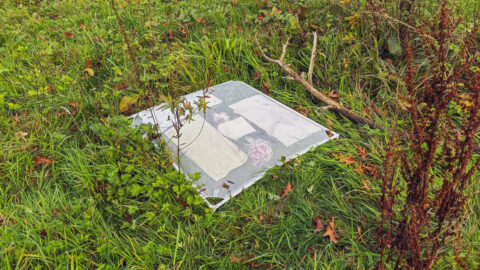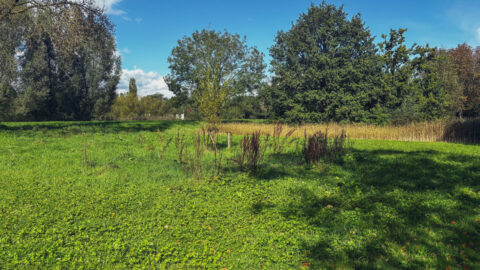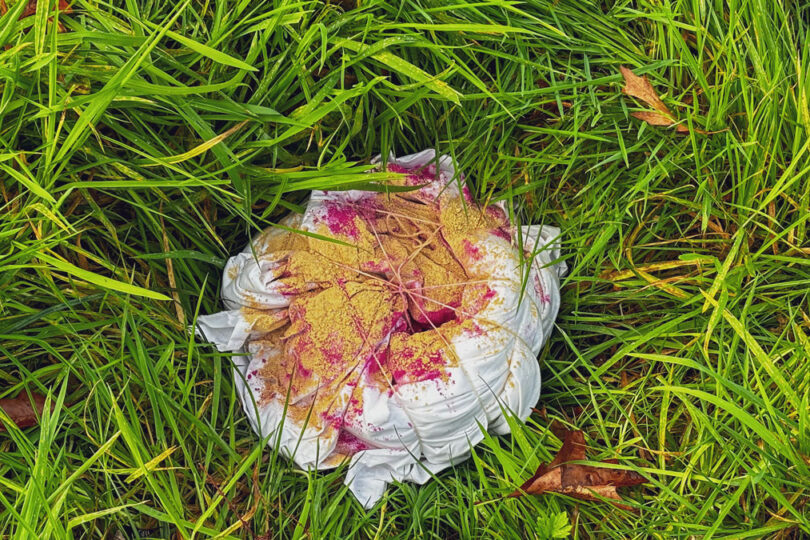A Pink Castle
In the autumn of 2024, visual artist Marloes Vreeswijk was given access to a 49m2 grassy field in Zaartpark, Breda. On this patch of land, she was allowed to do anything she wanted; there were no rules. This was agreed upon with the municipality of Breda, which had made an arrangement in 2016 with artist and founder of 49m2, Gerrit-Jan Smit. Within the 7 x 7 meter plot, anyone could intervene—except for the local authorities. Marloes experienced this freedom firsthand: during her working period, her experiments were removed from Zaartpark. What followed was an extensive search for the stolen art objects and a work period in which she delved deeper into the questions central to her artistic practice.
Pigments In The Grass
Before starting her residency at Zaartpark, Marloes had put a lot of thought into her plan. When she applied for the residency about two years earlier, she intended to build a pink castle precisely on the 49m2 plot. However, in the time between her application and the start of the residency, her artistic practice had evolved, making her initial plan no longer entirely align with her current approach. She decided to adjust her original idea and try something different: painting with grass.
Her new concept was as follows: “I want to capture the substrate of the 49m2 using pigments influenced by weather conditions.” By sprinkling pigments over the grass, she hoped to create an imprint of the ground. She did this by stretching an unbleached cotton cloth over a 1 x 1-meter frame and sprinkling pigments under the cloth onto the grass. She then pressed the frame with the cloth over the grass and pigments, allowing the elements to color both the fabric and the soil. Additionally, she scattered pigments on a large piece of fabric, folded it up, and buried it in a hole so that the elements could also influence it. She hoped moisture would interact with the cloths and pigments, forming colorful patterns. The imprints left on the fabric after the experiment would later be transformed into a tufted wall tapestry in the same colors.
Upon discovering that her experiments had been stolen, Marloes refused to be discouraged. She remained hopeful that her work was still somewhere near the grassy field. Perhaps someone had “tidied up” the pieces and thrown them in a bin. Together with her friend, she searched the entire Zaartpark, hoping to find traces of her cloths. Every square centimeter was combed through. But after hours of searching, they found nothing and decided to give up. They got in the car and headed home.

Een wit opgespannen doek van 1 x 1 meter is in het gras gezet met allerlei pigmenten tussen het gras en het doek.
Crime Scene Investigation
While driving, Marloes suddenly noticed something in the adjacent park through the car window—it resembled her experiment. A white frame with a white-pink cloth was floating in the park’s pond. They immediately turned the car around, resuming the search for the missing experiments. Armed with reed mats and a ball thrower but no dog, they ventured through the bushes toward the water. Along the way, they discussed the rescue plan. Who would go into the water if the spotted objects turned out to be Marloes’ experiments? And how would that person get back out? Upon reaching the pond and getting a closer look at the objects floating in the water, their hopeful mood turned once again to disappointment. It turned out to be a brightly colored Ola parasol. Despite their heroic rescue attempt, Marloes’ work remained missing. They returned home empty-handed. “It’s a sad story,” Marloes commented.
In the days that followed, Marloes considered how to respond to the theft. She wanted to create a counter-reaction—something that would make it clear that 49m2 was a place for artists. “I wanted to stand up for artists,” she explained. She considered reinstalling the two missing posts that framed the 7 x 7-meter square. Wrapping the field in red ribbon was another possibility. However, she ultimately decided against taking counteraction. “I didn’t want to smooth out the canvas for the next artist. I wanted to keep sharing the space as it was and leave the canvas blank once again.” A crucial motivation for this decision was her realization that she didn’t need to permanently claim space. “I don’t want to take up that much space. That feels like a kind of masculine energy I don’t want to contribute to.”

Het stuk 49m2 in september 2024 toen de werkperiode van Marloes Vreeswijk begon.
Keep believing in miracles
The theft of her experiments caused Marloes’ working period to unfold very differently from what she had planned or hoped for. However, she managed to turn her initial disappointment into an internal conversation about herself and her artistry. “Because my work was taken, that event made me deeply reflect on myself, my art, and my role as an artist. My work is always concerned with the question of ‘claiming space.’ What space am I allowed to take? How can I make space my own? Where am I allowed to be? That’s why I found it almost fitting that this happened—the work period shifted from a physical experiment to a conversation about space and occupying it.”
The conversation Marloes and her friend had during their rescue attempt was recorded by Marloes on video. She later developed it into a script, which now serves as the foundation for her reflection on her work. One of the phrases that emerged from the conversation was: “At least we still believe in miracles.” Marloes explained, “I find that very characteristic of me, my work, and what 49m2 represents. I truly believed that I could claim my own place on 49m2 and be myself as an artist. But I quickly realized that even there, on ‘my’ 49m2, I had to share the space.” The hope Marloes felt when she was granted a grassy field of her own, and the simultaneous tragedy of the falsehood of that idea, are embedded in that English phrase.
The tension between Marloes’ hopeful artistic perspective and the often harsh reality is a recurring theme in her work. There is a constant struggle between Marloes the artist and Marloes the citizen. As an artist, she lives in a dream world where she expects the best—a pink castle in a positive, feminine world full of glitter. The citizen in her, however, feels the weight of reality—the harsh world where there is little room for art and imagination. The fact that the boundaries of the grassy field, which symbolized Marloes’ glittery, positive world—the place where her art was supposed to be and where she could claim space—were crossed, gave her much to think about. “My artistry is very broad, but its core remains the same. It’s a search for space. I have now explored that core question in a very different way than I initially intended. It has become a philosophical investigation that is still ongoing. The questions remain unanswered, and that’s okay. The journey itself is the work.”
At the end of her working period, Marloes did not present a finished artwork. Instead, she examined the essence of her artistry and the position she occupies as an artist. The search itself became the space she was seeking—always in motion, never complete.
By Charlotte Fijen, December 2024

